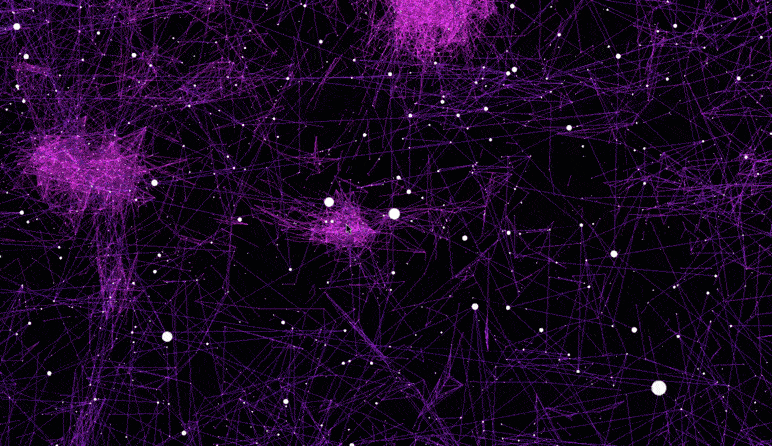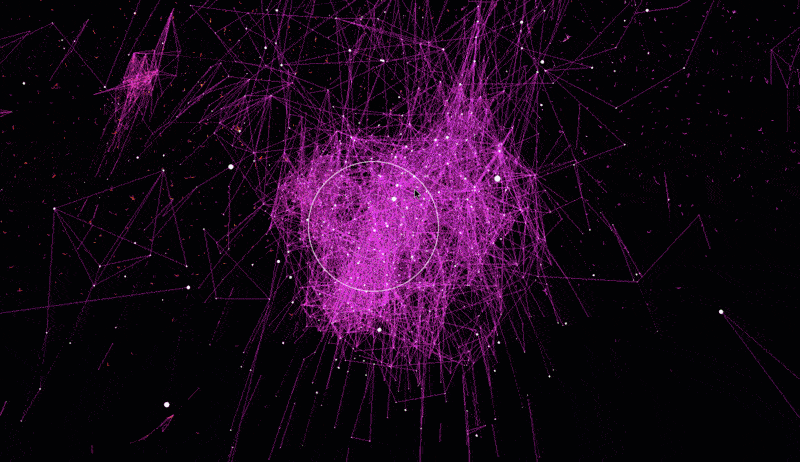word2vec graph
This visualization builds graphs of nearest neighbors from high-dimensional word2vec embeddings.
Available Graphs
The dataset used for this visualization comes from GloVe, and has 6B tokens, 400K vocabulary, 300-dimensional vectors.
-
Distance < 0.9 - In this visualization edge between words is formed when distance between corresponding words' vectors is smaller than 0.9. All words with non-word characters and digits are removed. The final visualization is sparse, yet meaningful.
-
Distance < 1.0 - Similar to above, yet distance requirement is relaxed. Words with distance smaller than 1.0 are given edges in the graph. All words with non-word characters and digits are removed. The visualization becomes more populated as more words are added. Still meaningful.
-
Raw; Distance < 0.9 (6.9 MB) - Unlike visualizations above, this one was not filtered and includes all words from the dataset. Majority of the clusters formed here have numerical nature. I didn't find this one particularly interesting, yet I'm including it to show how word2vec finds numerical clusters.
Common Crawl
I have also made a graph from Common Crawl dataset (840B tokens, 2.2M vocab, 300d vectors). Words with non-word characters and numbers were removed.
Many clusters that remained represent words with spelling errors:
I had hard time deciphering meaning of many clusters here. Wikipedia embeddings were much more meaningful. Nevertheless I want to keep this visualization to let you explore it as well:
- Common Crawl visualization - 28.4MB
Intro and Details
word2vec is a family of algorithms that allow you to find embeddings of words into high-dimensional vector spaces.
// For example
cat => [0.1, 0.0, 0.9]
dog => [0.9, 0.0, 0.0]
cow => [0.6, 1.0, 0.5]
Vectors with shorter distances between them usually share common contexts in the corpus. This allows us to find distances between words:
|cat - dog| = 1.20
|cat - cow| = 1.48
"cat" is closer to "dog" than it is to the "cow".
Building a graph
We can simply iterate over every single word in the dictionary and add them into a graph. But what would be an edge in this graph?
We draw an edge between two words if distance between embedding vectors is shorter than a given threshold.
Once the graph is constructed, I'm using a method described here: Your own graphs to construct visualizations.
Note From practical standpoint, searching all nearest neighbors in high dimensional space is a very CPU intensive task. Building an index of vectors help. I didn't know a good library for this task, so I consulted Twitter. Amazing recommendations by @gumgumeo and @AMZoellner led to spotify/annoy.
Data
I'm using pre-trained word2vec models from the GloVe project.
Preprocessing
My original attempts to render word2vec graphs resulted in overwhelming presence
of numerical clusters. word2vec models really loved to put numerals together (and
I think it makes sense, intuitively). Alas - that made visualizations not very
interesting to explore. As I hoped from one cluster to another, just to find out
that one was dedicated to numbers 2017 - 2300, while the other to 0.501 .. 0.403
In Common Crawl word2vec encoding, I removed all words that had non-word characters or numbers. In my opinion, this made visualization more interesting to explore, yet still, I don't recognize a lot of clusters.
Local setup
Prerequisites
Make sure node.js is installed.
git clone https://github.com/anvaka/word2vec-graph.git
cd word2vec-graph
npm install
Install spotify/annoy
Building graph file
- Download the vectors, and extract them into graph-data
- Run
save_text_edges.py -hto see how to point it to th newly extracted. vectors (also see file content for more details) - run
python save_text_edges.py- depending on input vector file size this make take a while. The output fileedges.txtwill be saved in thegraph-datafolder. - run
node edges2graph.js graph-data/edges.txt- this will save graph in binary format intograph-datafolder (graph-data/labels.json, graph-data/links.bin) - Now it's time to run layout. There are two options. One is slow, the other one is much faster especially on the multi-threaded CPU.
Running layout with node
You can use
node --max-old-space-size=12000 layout.js
To generate layout. This will take a while to converge (layout stops after 500 iterations).
Also note, that we need to increase maximum allowed RAM for node process
(max-old-space-size argument). I'm setting it to ~12GB - it was enough for my case
Running layout with C++
Much faster version is to compile layout++ module. You will need to manually
download and compile anvaka/ngraph.native package.
On ubuntu it was very straightforward: Just run ./compile-demo and layout++
file will be created in the working folder. You can copy that file into this repository,
and run:
./layout++ ./graph-data/links.bin
The layout will converge much faster, but you will need to manually kill it (Ctrl + C) after 500-700 iterations.
You will find many .bin files. Just pick the one with the highest number,
and copy it as positions.bin into graph-data/ folder. E.g.:
cp 500.bin ./graph-data/positions.bin
That's it. Now you have both graph, and positions ready. You can use instructions from
Your own graphs to visualize your
new graph with https://anvaka.github.io/pm/#/



